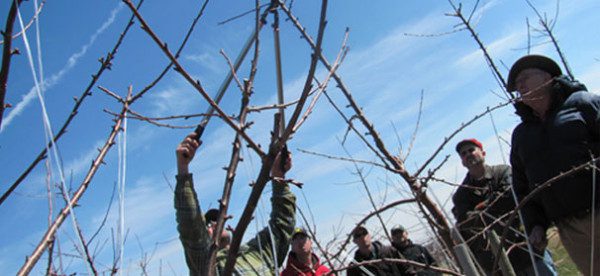
Apr 29, 2011Project studies rootstock, training system combinations
Gregory Lang, a Michigan State University (MSU) professor, talked rootstocks and training systems with a group of about 70 growers March 30, during a tour of sweet cherry operations around Grand Rapids, Mich.
The morning began with Lang leading the group through a research plot at MSU’s Clarksville Horticultural Experiment Station. The plot is one of about a dozen scattered throughout North America, which Lang coordinates as part of the NC-140 Regional Rootstock Research Project. Once a year, participants in the project get together to compare data and notes – to see what’s working and not working at each location, Lang said.
The purpose of the Clarksville trial is to study the three rootstocks used in the plot – Gisela 3, Gisela 5 and Gisela 6 – and their interactions with four different training systems, to find the most optimal combinations, he said.
These are the high-density, small-stature training systems being studied at the Clarksville plot: Tall Spindle Axe (TSA), Super Slender Axe (SSA), Upright Fruiting Offshoots (UFO) and Kym Green Bush (KGB).
One of the goals of each training system: A minimum amount of permanent wood, so each tree puts less energy into its structure and more energy into its fruit. Another goal is to cycle the renewal of fruiting wood so that none of it is more than five years old. The best cherries tend to come from younger wood, Lang said.
In the last decade, researchers have learned a lot more about the fruiting physiology of cherry, and particularly how fruiting is impacted by highly productive, precocious rootstocks. Combine that knowledge with more efficient training systems, improved varieties and tools like high tunnels for climatic modification, and it’s changing the outlook for fresh-market sweet cherry production worldwide, he said.
Lang spent two weeks on a USAID project in Serbia in February, and found growers there hugely excited about the prospect of growing sweet cherries. He also spent two weeks in China last September, where he learned the Chinese government is investing millions of dollars to increase and modernize fresh-market cherry production.
Recommendations
Lang had some recommendations for growing big sweet cherries on Gisela rootstocks.
During the first year, focus on establishing a strong root and leader system and moderately vigorous, uniform laterals. Provide frequent, consistent irrigation and fertilization to promote and maintain active initial growth. When a cherry tree on Gisela stops growing due to environmental stress, it can be difficult to get it to resume growing that season, according to Lang.
- If establishing a TSA, SSA or UFO system, do not head nursery trees. If establishing multiple leaders, such as for the KGB system, head above strong, well-distributed buds.
- Use bud selection and bud removal at bud swell to promote improved distribution of lateral shoots that will be the future fruiting sites. Apply copper before or after to reduce bacterial canker potential.
- When new lateral shoots are 4 to 5 inches long, use clothespins to establish 90-degree crotch angles. Wider angles are stronger and less susceptible to bacterial canker infections.
During the second year, continue to initiate well-distributed lateral shoots by using bud selection and removal on the part of the leader that grew the previous season. Remove and re-start (by pruning back to a basal vegetative bud) any overly vigorous lateral shoots from the previous year to prevent them from becoming dominant.
- The greater the number of lateral shoots that can be initiated during each of the establishment years, the more balanced the resulting growth.
In the third year, focus on balancing future fruiting spurs, leaf area and vigor.
- Remove weak lateral shoots by thinning cuts or stubbing; remove any unbalanced vigorous growth in the tops of leaders. Reduce lateral length by heading-cut removal of 15-30 percent of each future fruiting shoot (amount removed should be proportional to shoot vigor); this strengthens the future fruiting wood structure and removes the terminal section of the shoot that tends to form dense clusters of fruiting spurs.
- To optimize crop load, prune before budbreak. Remove pendant shoots, strongly upright shoots, weak shoots and shoots with excessive blind wood.
- To control excessive growth, prune in late summer – especially for the leaders and upper laterals. Doing this also improves light distribution throughout the canopy for the development of strong spur buds, according to Lang.
By Matt Milkovich














